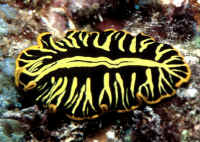

Prescott considers the appearance of the platyhelminthes in the fossil record (565 to 544 million years ago) to be a breakthrough in the evolution of action selection - i.e. the task of resolving conflicts between behavioural alternatives. He cites research by Raup and Seilacher (1969, cited in Prescott, 2001, pp. 12 - 13) showing that trace fossils of meandering foraging trails left by the earliest flatworms, which are described in detail in the Appendix, can be generated by combining four simple behaviour mechanisms: stay close to previously formed tracks; avoid crossing existing tracks; advance when the preceding conditions are not met; and make 180 degree U-turns at various intervals, which is achieved by swapping control from one side of the body to the other at various intervals. While the first two behaviour patterns are reflexive mechanisms associated with an animal's peripheral sensors, and the third mechanism (advance) is merely a default, the behavioural component that suppresses signals from one side of the body while the other is active, functions as a centralised conflict-preventing mechanism, of vital importance to an organism with a brain and bilateral symmetry.
Should the ability of bilaterally symmetric animals to engage in centralised action selection be envisaged in mentalistic terms, as a primitive form of intelligent behaviour? Or is there an alternative, neutral description of this behaviour? Robotics researchers such as Mataric (1990, cited in Prescott, 2001, p. 13) have pointed out that the first three mechanisms are the same as those used by a robotic wall-follower, while the U-turn behaviour can be generated simply by transferring control of staying close to the wall from one sensor arm to the other.
In keeping with the methodology I have advocated above, we should refrain from imputing mental processes to the simplest animals with brains, unless it helps us to understand and predict their behaviour better. The action selection mechanism described above does not appear to require such an explanation. Even if the foraging strategy being used is an optimal one, for a creature relying solely on physical contact (touch, taste and smell) to find food, the strategy may well be a fixed action pattern. It has been argued above (Conclusion N.11) that there can be no "true" learning (and hence no mental states) in an organism unless its behavioural response patterns are flexible. The fact that flatworms' action selection mechanisms (unlike those of cnidaria) are centralised does not imply that they are flexible.
Following this line of thinking, we should look for flexibility in flatworms' patterns of flexible behaviour (e.g. variations in their foraging strategies in response to environmental changes), before attempting to explain their foraging in mentalistic terms. For instance, if a flatworm could be conditioned to adjust its foraging strategy (e.g. by changing the length of its meander or the timing of its U-turns) in response to certain stimuli, we might interpret this as evidence of "thoughtful" foraging. I have not been able to find a discussion of any such experiments in the literature. This would be a fruitful area for further research.
S.11 The occurrence of centralised action selection, sensors and a central nervous system in an organism does not provide a sufficient warrant for the ascription of mental states to it.
*** SUMMARY of Conclusions reached